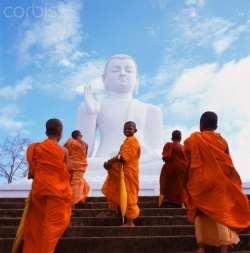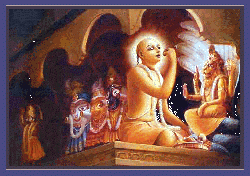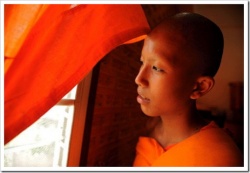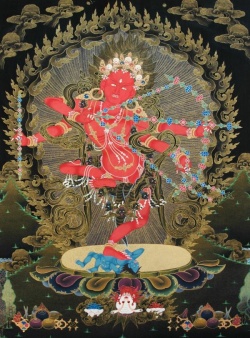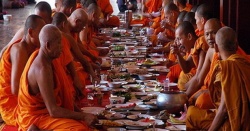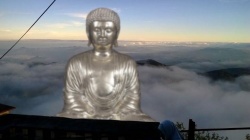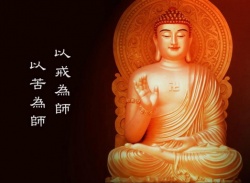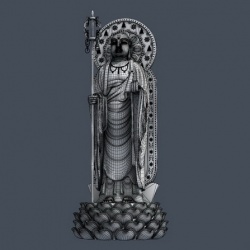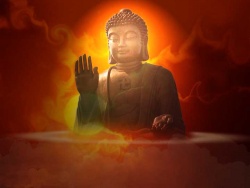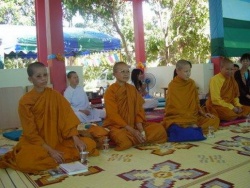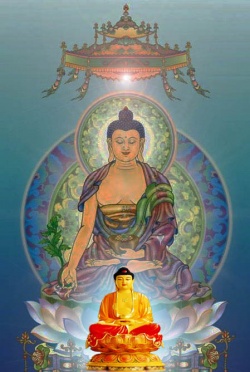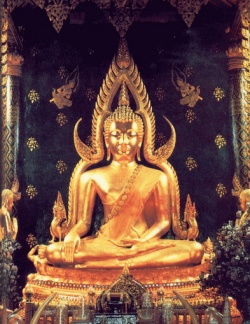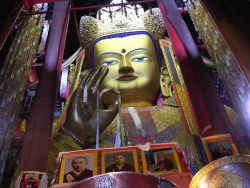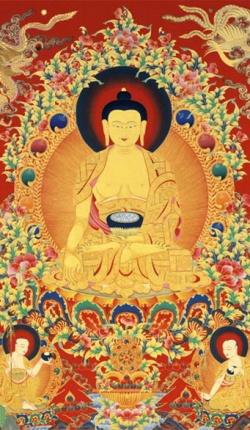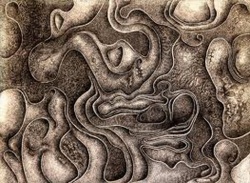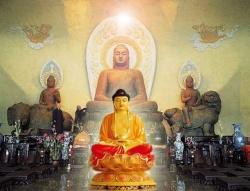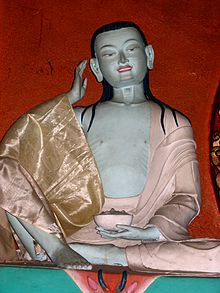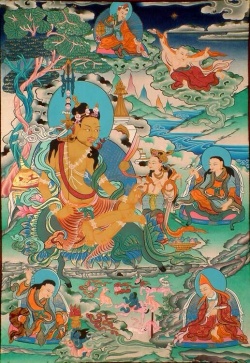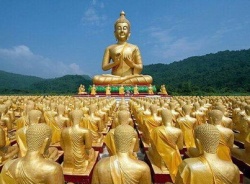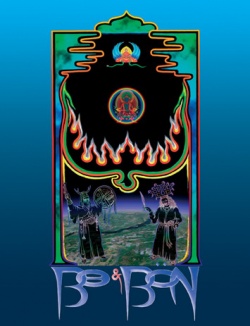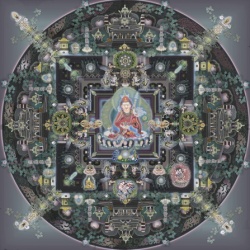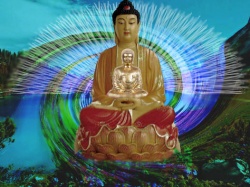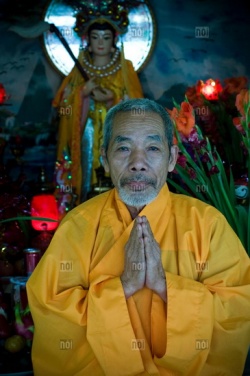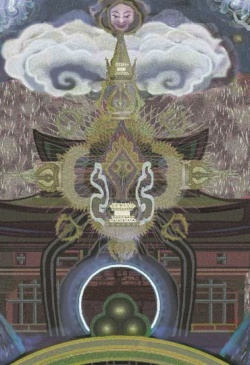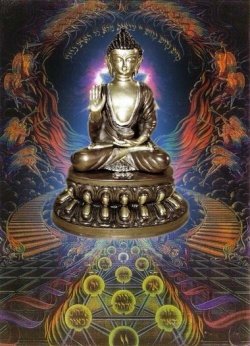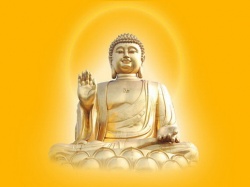The Life of Atisha
Geshe Ngawang Dhargyey oral translation by Sharpa Tulku prepared and edited by Alexander Berzin lightly revised by Alexander Berzin, November 2003
Original version excerpted from Anthology of Well-Spoken Advice, vol 1. Dharamsala, India: Library of Tibetan Works & Archives, 1982.
Order the original text directly from Snow Lion Publications.
Childhood and Renunciation of Princely Life
In eastern India, in the land of Jahor, in the city of Bangala, in the Golden Banner Palace, lived King Kalyana the Good and Queen Prabhavati the Radiant.
The royal palace was crowned with thirteen golden roofs, one set atop the other, and magnificently adorned with 25,000 golden banners.
It was surrounded by countless parks, pools, and beautiful gardens.
The kingdom was as rich as the ancient, opulent dynasties of China.
The royal couple had three sons, Padmagarbha, Chandragarbha, and Shrigarbha. It was this second prince, who grew up to become our illustrious teacher, Atisha (Jo-bo rje dPal-ldan A-ti-sha) (982-1054 CE).
When Atisha was eighteen months old, his parents held his first public audience at the local temple, Kamalapuri.
Without any instruction, he prostrated to the venerable objects inside and spontaneously recited, "Because of the compassion of my parents, I have attained a precious human life rich with the opportunity to view all you great figures.
I shall always take from you my safe direction (refuge) in life."
When introduced to his royal subjects outside, he prayed to realize his fullest potential in order to satisfy their every need.
He also prayed to be able to take the robes of a spiritual seeker who has renounced family life, never to be proud, and always to have compassionate sympathy and loving concern for others.
This was most extraordinary for such a young child.
As Atisha grew older, his wish to become a mendicant monk increased ever stronger, but his parents had different expectations.
Of their three sons, he was the brightest, and the auspicious omens at his birth helped convince them that he should be the royal successor.
Therefore, when the boy reached eleven, the customary age for marriage at that time, they made elaborate preparations for him to take a bride.
On his wedding eve, the Buddha-figure (yidam) Tara appeared to Atisha vividly in a dream.
She told him that for 500 consecutive lives he had been a mendicant monk and therefore not to have any attraction for the transitory pleasures of this world.
She explained that an ordinary person caught up in them would be relatively easy to rescue, like a goat trapped in quicksand. But, as a royal prince, he would be as difficult to extract as an elephant.
The boy told no one about this dream, but on other grounds cleverly excused himself from this marriage.
Having firmly resolved to find a spiritual teacher, but telling his parents he wished to go hunting, Atisha now left the palace with 130 horsemen.
First, he met in the jungle the holy Jetari, a man of the brahmin priestly caste who was living as a Buddhist recluse.
From him, the lad formally accepted a safe direction in life and took the bodhisattva vows.
This holy man then sent him to the sequestered monastic university of Nalanda and the spiritual master Bodhibhadra.
Atisha immediately set off with all his horsemen and there, from Bodhibhadra, he again received the bodhisattva vows and teachings.
He was next directed to the great Vidyakokila for further instruction and then on to the famous Avadhutipa.
This latter master advised the boy to return home, treat everyone respectfully, but try to see the drawbacks of such a luxurious life and then report back.
Atisha’s parents were delighted to see him and thought at last he would settle down, take a wife, and prepare for his future rule.
However, the lad informed them that he had in fact gone in search of a spiritual teacher for guiding direction.
He confessed that all he wished was to lead a quiet, contemplative life and had come for permission to take leave of his princely duties.
Shocked at his words, his parents tried to dissuade him from leaving.
They said he could combine both lives and offered to build sequestered monasteries near the palace and let him study, feed the poor and so on.
They pleaded with him not to return to the jungle. But, Atisha told them he had not the slightest attraction to royal life.
"To me," he said, "this golden palace is no different from a prison.
The princess you offer is no different from a daughter of the demons, the sweet food no different from the rotted flesh of a dog, and these satin clothes and jewels are no different from rags from the garbage heap.
From this day onwards, I am determined to live in the jungle and study at the feet of the master Avadhutipa. All I ask is for some milk, honey, and brown sugar and I shall take my leave."
There was nothing his parents could do but consent to his request and so Atisha returned to the jungle with these provisions and an embarrassingly large entourage of royal attendants they insisted accompany him.
Avadhutipa now sent the young prince to the master Rahulagupta, on the Black Mountain, to enter the practice of tantra.
Atisha arrived with all his horsemen and told this vajra master how he had studied with many teachers, but still was unable to shake off his bondage to royal life. Rahulagupta conferred upon him his first empowerment, which was into the practice of Hevajra, a Buddha-figure with which to bond his mind.
He then sent him back to the palace with eight of his disciples, four male and four female, dressed scantily in the bone ornaments of mahasiddhas, great adepts with actual attainments.
For three months, Atisha stayed in the environs of the palace with these strange new companions, behaving in a completely unconventional and outrageous manner.
In the end, his parents were forced to give up all hopes for their precious son.
Thinking him to have gone mad, they gave full permission for him to leave with his rather unsavory-looking friends and be gone once and for all.
Studies in India and the Golden Isle
Atisha immediately ran back to his master Avadhutipa and now, from the age of twenty-one to twenty-five, studied intensively the Madhyamaka middle way outlook of reality.
During this period, he also studied with many other highly accomplished teachers and became extremely well versed in all systems of tantra practice.
In fact, he became rather proud of his erudition and felt he was rather clever with these hidden measures to protect the mind and that he had mastered all their texts.
But then, he received a pure vision of a dakini, a celestial maiden whose movements are unimpeded by ignorance, who held in her arms many volumes on the everlasting streams of such tantra systems.
She told him, "In your land, there are only a few such texts, but in our land there are so many."
After this, his pride was deflated.
One day, he decided to go off and devote all his energies to the tantra practices in order to realize his fullest potential in his very life.
His vajra master, Rahulagupta, then appeared in a dream and advised him not to do so and desert everybody, but to become a mendicant monk.
He should continue in this manner with steady practice and achieve perfect enlightenment in its due course of time.
Thus, at the age of twenty-nine, Atisha received from the stable elder, Shilarakshita, the robes of a spiritual seeker who has renounced family life and was given the name Dipamkara Jnana, "He Whose Deep Awareness Acts as a Lamp."
During his first twelve years after taking robes, Atisha studied at the monastic university of Odantapuri with the great Dharmarakshita, the author of the famous lojong (blo-sbyong, mind-training) text for cleansing our attitudes, The Wheel of Sharp Weapons.
They focused on all the Hinayana or modest-minded measures to take as a vehicle leading to liberation, but Atisha was always dissatisfied.
He longed for the fastest way to realize his fullest potential.
[See: The Wheel of Sharp Weapons, 2006 Literal Translation.]
His vajra master Rahulagupta told him, "It does not matter how many pure visions you receive, you must train to develop caring love, compassionate sympathy, and a bodhichitta aim totally dedicated to benefiting others and to achieving enlightenment."
He advised him to commit himself wholeheartedly to the Buddha-figure Avalokiteshvara, to bond his mind closely with him and work to become enlightened so that he could best free everyone from samsara, uncontrollably recurring existence.
Only with this achievement would he realize his fullest potential.
At Vajrasana, the Vajra Seat, at modern Bodh Gaya, while circumambulating the great stupa relic monument for honoring the Buddha, Atisha heard two statues whispering to each other in a niche overhead.
One asked the other, "If you wish to achieve enlightenment as quickly as possible, in what should you train?" "A totally dedicated heart of bodhichitta" was the reply.
And while circumambulating the cupola of the monument, a statue of Buddha, the Vanquishing Master Surpassing All, spoke to him saying, "O mendicant monk, if you wish to realize your fullest potential quickly, train in love, compassion, and bodhichitta."
At that time, the most famous master holding the complete teachings on how to develop bodhichitta was Dharmakirti (Dharmapala) the Sublime Teacher from Suvarnadvipa, the Golden Isle.
Thus, with a group of 125 learned monks, Atisha set off on a ship of merchants bound for the Golden Isle, modern Sumatra.
In those days a long ocean voyage was not an easy affair and they had a particularly difficult passage with storms, whales, and losing their way.
It took thirteen arduous months to complete their journey, but Atisha remained undaunted throughout.
When they finally landed, Atisha did not go at once to the famous master, but stayed instead for a full two weeks with a group of this master’s disciples.
He prodded them over and again for information about their teacher and insisted on his full biography.
This shows us the importance of thoroughly examining a spiritual master and checking his or her qualifications before going to study.
Meanwhile, this Sublime Teacher from the Golden Isle had heard of the arrival from India of the learned scholar and his mendicant companions on their spiritual quest.
He assembled his own community of monks for the welcome and when Atisha arrived, they performed together many formal ceremonies auspicious for the future.
He also presented Atisha with a Buddha statue and predicted that one day he would tame the minds of the people of the northern Land of Snow.
Atisha stayed in the Golden Isle for twelve years, avidly training with this master.
First, he studied A Filigree of Realizations (mNgon-rtogs rgyan, Skt. Abhisamaya-alamkara) the Triumphant Maitreya’s guideline instructions for fathoming the Omniscient One’s Sutras of Far-reaching Discriminating Awareness (Sher-phyin-gyi mdo, Skt. Prajnaparamita Sutras).
He then gradually received the full teachings on extensive behavior from the lineage of Maitreya and Asanga, as well as those of the special lineage on exchanging selfishness for concern with others, which the bodhisattva Shantideva, a spiritual son of the Triumphant, had received directly from the ennobling, impeccable Manjushri himself.
After Atisha gained, through these methods, a full-realization of a bodhichitta aim, he returned to India at the age of forty-five and resided thereafter mostly at the sequestered monastic university of Vikramashila.
All in all, Atisha studied with 157 great teachers, but he had such exceptional reverence for this magnificent teacher from the Golden Isle and the measures he imparted that tears would well in his eyes whenever he mentioned or heard his name.
When later asked by his Tibetan disciples if this display of emotion meant that he favored one of his teachers above all others, Atisha replied, "I make no distinctions among all my spiritual mentors.
But because of the kindness of my sublime master from the Golden Isle, I have gained peace of mind and the dedicated heart of a bodhichitta aim."
Inviting Atisha to Tibet
After Atisha’s return to India, he protected and upheld the Triumphant One’s hallowed Dharma by three times defeating in formal debate non-Buddhist extremists.
Within the Buddhist fold, he established many institutes of learning wherever he traveled, and whenever he saw signs of degenerate or misinformed practices, he would immediately reform them.
His fame spread throughout India.
Because of his compassion and insight, he was revered as the crowning jewel of the erudite masters.
He conferred the greatest benefit, however, on the people of Tibet, the Land of Snow.
Although the Buddha Dharma had been brought to Tibet several centuries earlier through the efforts primarily of Guru Rinpoche Padmasambhava (Gu-ru Rin-po-che Pad-ma ‘byung-gnas) and several others, this early flowering suffered a great setback due to repression by King Langdarma (Glang-dar-ma) (863 – 906 CE).
Few practitioners were left and afterwards many points were no longer properly understood.
Many felt that the practices of ethical self-discipline and tantra were mutually exclusive and that enlightenment could be achieved through intoxication and various forms of sexual misconduct.
Others believed that likewise contradictory were the teachings of Hinayana and Mahayana, leading respectively to liberation and enlightenment.
Saddened by this degenerate condition, the Tibetan king Yeshey-wo (Ye-shes ‘od) wished very strongly to invite a learned master from one of the great monastic centers of India to come to Tibet and clarify the confusion.
Not knowing specifically of Atisha, he sent twenty-one young men to study Sanskrit and locate a suitable master.
All but two died of the heat. Unable to invite anyone, but having learned the language, the new translators Rinchen-zangpo (Rin-chen bzang-po) (958 – 1051 CE) and Legshay (Legs-bshad) returned to the king and informed him about Atisha.
As soon as he heard his name, the king decided that this Atisha was the person who was needed.
Wasting no time, he sent a second party of nine, headed by Gyatsonseng (rGya brtson-‘grus seng-ge), with much gold to invite this master.
But the eight companions died as well and, unable to bring Atisha, Gyatsonseng stayed on in India. When news of this second failure reached Yeshey-wo, he decided to lead an expedition himself to collect more gold for yet another party.
But on this mission, he was captured on the Nepalese border by the rival King of Garlog (Gar-log, Qarluq), who wished to prevent the further spread of Buddhism in Tibet.
King Yeshey-wo’s nephew, Jangchub-wo, was informed either to give up this mission to India or to raise an amount of gold equal to the size of his uncle in order to secure the hostage’s release.
The nephew traveled about the kingdom, but was only able to collect gold equal to the King’s torso and limbs.
He could not raise the additional gold for his head.
When the Garlog ruler demanded the full measure of ransom, the nephew requested permission to see his uncle.
He was taken to a dark prison cell enclosed by iron bars.
There he explained the situation to his uncle, who was in chains and very frail, and said he would continue to search for the remaining gold.
"Do not give up hope," he told his uncle, "for I shall raise the ransom.
I could wage war with this Garlog king, but many would be killed. Buying your freedom seems best."
"My dear nephew," the aged King replied, "I never expected you to have such compassion and wisdom.
I am pleased that you understand the evils of violence, but now you must forget about me. Instead, use all the gold you have collected to invite to Tibet the great master Atisha.
I have died countless times in previous lives, but I am sure I have never before sacrificed myself for the Triumphant One’s Dharma.
Now I am very happy to do so.
Whomever you send to India, please have him tell Atisha that I have given my life for the welfare of my subjects and the Dharma so that he could be brought to Tibet.
Although I have not had the fortune to meet him this lifetime, I have fervent hopes that I can in the future."
The nephew submitted to his uncle’s command and departed, nearly overcome by grief.
Jangchub-wo, now became King of Tibet.
He decided that the best person he could send on this third mission would be the translator Nagtso (Nag-mtsho Lo-tsa-ba), who had already been to India several times.
The new king invited him to the palace and, insisting that the translator sit on the royal throne, pleaded with him.
"My uncle died so that Atisha could be invited to Tibet.
If his wish is not fulfilled, the troubled people of this land will surely fall into terrible rebirths.
I beg you to save these unfortunate beings." The young king then broke down and wept. Nagtso had no choice but to accept and brave the hardships of yet another journey to India.
The translator set off with 700 gold coins and six companions.
The King escorted them for several days and, before taking his leave, reminded Nagtso to tell Atisha, "This is the last of the gold in Tibet and my uncle was the last of Tibet’s great men.
If he has any compassion for others, he must come.
If the barbarians of Tibet have such concern for the Dharma and he has none, then Buddhism has indeed weakened and there is no hope!" The King then turned back to his palace.
On the way to India, the delegation met a young boy who asked the purpose of their journey.
When told, he was very pleased and said, "You will be successful in your quest if you always recite this prayer,
‘I make obeisance to and take safe direction from Avalokiteshvara. I request that the Triumphant One’s Dharma flourish in Tibet.’"
When asked who he was, the boy said they would find out in due time.
Eventually, the travelers reached the sequestered monastic university of Vikramashila late one night and camped at the gates. In a room above, lived Gyatsonseng, the Tibetan who had led King Yeshey-wo’s second mission.
When he heard voices speaking his native tongue, he looked down with great surprise and, seeing the party camped below, asked why they had come.
The Tibetans excitedly related their story, and even disclosed that the purpose of their mission was, in fact, to bring Atisha himself back to Tibet.
Gyatsonseng warned them not to reveal their aims so openly.
He advised them to leave their gold with the boy posted at the gate and come to see him in the morning.
The travelers did so and the small boy told them to rest and to trust him.
Early the next day, the lad woke them and asked why they had come.
When they told him everything, the boy said crossly, "You Tibetans talk too much! You must keep this quiet. Otherwise, there will be much interference.
Important things should never be done in haste, but always slowly, carefully, and in secret."
He then returned their gold coins and led them into the enormous monastic grounds.
The party met an old man who greeted them and asked where they were from and why they had come.
Again, they made no attempt to hide anything and the old man scolded them, "If you continue indiscreetly like this, you will never accomplish your goal.
Tell your mission only to Atisha." He then offered to show them to Gyatsonseng’s room.
Although he walked slowly with a cane, no one could keep up with him, for he too, like the small boys before, was an emanation of Avalokiteshvara, overseeing their mission.
Now the Tibetans decided on a plan of action. Gyatsonseng told them to say they had come to study Sanskrit.
"Our chief abbot, the elder Ratnakara, is Atisha’s superior and regards him very highly.
If he hears of your real purpose, he will make sure you never even meet Atisha."
The next morning, they reported to the Abbot and presented him with half their gold coins.
They told him that in the past many of their countrymen had come to India seeking to invite to Tibet such erudite masters as Atisha.
However, they had come to study and become learned themselves.
The venerable elder was greatly relieved and said, "By all means do that. Do not misunderstand.
It is not that I have no compassion for Tibet, but Atisha is one of our most highly realized masters, especially in terms of his bodhichitta.
If he does not remain in India, there is no hope for the Buddha’s teachings to be preserved in their birthplace."
The Abbot, however, was still highly suspicious of these foreigners and prevented them from meeting Atisha.
The Tibetans, convinced that their ploy had worked, began to attend classes and bided their time.
After several months, an important monastic ceremony was held.
As everyone was required to attend, the travelers hoped that at last they would catch a glimpse of Atisha.
As they watched and waited, many great masters made their entrance.
Some, like the famous Naropa, came surrounded by a huge retinue.
Others were preceded by attendants bearing flowers and incense.
Finally, Atisha arrived. He was dressed in old tattered robes, with the chapel and storehouse keys tied to his waist.
The Tibetans were sorely disappointed with his unimpressive appearance and asked Gyatsonseng if they could invite one of the other more glamorous masters instead.
Gyatsonseng told them, "No, Atisha has a very special close bond with Tibet and, despite his appearance, he is the one you must bring back."
Finally, a secret meeting was arranged. Nagtso presented Atisha with the gold coins piled high on a round mandala offering plate and told him the history of how the hallowed Dharma had degenerated in Tibet.
Relating the story of King Yeshey-wo’s sacrifice and repeating the words of both the uncle and nephew, Nagtso pleaded with him to come.
Atisha told them they were very kind and that he had no doubt that those Tibetan kings were in fact bodhisattvas.
He was aware of the problems and sincerely respected the King for his sacrifice, but they must try to understand he was getting on in years and had many responsibilities as keeper of the monastery’s storehouse.
He hoped it would be possible to come and returned their gold for the journey home.
"Meanwhile," he told them, "I must consult with my personal yidam."
That night, Tara appeared to Atisha in a pure vision and told him his journey would be a complete success.
He would benefit the Tibetans enormously and would find among them a disciple with an especially close bond to him.
This would be an upasaka, a man with lay vows, and he would spread the Dharma even further.
"But," she told him, "if you remain in India, you will live to be ninety-two, whereas if you go to Tibet your life span will be seventy-two years."
Atisha now felt confident to go with the Tibetans and that it was worth the sacrifice of twenty years of his life if he could truly benefit others.
He would have to find some clever means to obtain leave from his shrewd abbot.
First, he asked permission to make pilgrimages to the east, south, and west of Vikramashila.
This was granted and he visited a number of holy places. He then asked to make a similar journey to the north, but the Elder, sensing his hidden motive, refused.
The Tibetan delegation was thrown into great despair and decided the only hope was to tell the Abbot the entire truth.
The stable Elder pretended to be angry, and the Tibetans immediately fell to their knees and pleaded for forgiveness.
"My reasons for not wishing to give you Atisha are the same as before," the Abbot began, "but because the need of Tibet is so great, I am willing to let him remain in your land for three years.
However, you must promise to return him to India after that time." Overwhelmed with joy, the Tibetans pledged their word.
Reforming and Revitalizing the Dharma in Tibet
Thus, at the age of fifty-three, Atisha set out on the long journey to the Land of Snow.
On route, the translator Gyatsonseng fell ill and died.
In grief, Atisha declared, "Now my tongue has been cut out!"
Then Nagtso humbly bowed before him and said, "Please do not worry.
Although my Sanskrit is not perfect, it will surely improve. There are others as well who maybe can serve you."
In Nepal, they met the great eye-opening translator Marpa (Mar-pa Lo-tsa-ba) (1012 – 1099 CE), who was on his way to India for the third time.
Atisha invited him to be his interpreter, but Marpa excused himself by saying, "It was my teacher’s wish that I visit India three times. Now, I must make this final journey."
They also met the aged translator Rinchen-zangpo, but he too was unable to help. "As you can see by the white hair on my head," he said, "I am very old. I have worked all my life without ever the chance for doing intensive practice."
Thus, Atisha went on, forced to rely on Nagtso’s limited skills.
After two years of travel, the party finally arrived in Upper Tibet (sTod, western Tibet) at the city of Ngari (mNga’-ri), the capital of Yeshey-wo’s kingdom.
Both the householders and the monks formed a grand procession and invited Atisha to stay at the nearby sequestered monastery.
The Indian master was overjoyed at this enthusiasm for the Triumphant One’s teachings and was greatly surprised at the number who had taken the robes of a spiritual seeker.
Many learned people came from all over Tibet.
He was so impressed with the profundity of their questions concerning the Sage Buddha’s sutras and tantras that he wondered why they had gone to so much trouble to invite him when there were already so many masters.
However, when he quizzed them back as to how these two sets of preventive measures formed an integral whole, they were unable to answer.
Atisha now knew the purpose of his mission.
One day, King Jangchub-wo requested a teaching for the people of Tibet.
"We do not want one on measures that are so vast and profound we shall be unable to adopt them," he said.
"What we need is something that will tame our minds and enable us to deal with our everyday impulsive behavior (karma) and its results.
Please teach us the measures you yourself take."
Atisha was so enchanted by the simplicity and sincerity of the King’s request that in later years he referred to him as "my excellent disciple."
Had he been asked for advanced empowerments into tantric deity systems or for practices conferring special powers, he would have been far less pleased.
Thus, he spent three years at Ngari giving discourses later compiled into A Lamp for the Path to Enlightenment (Byang-chub lam-gyi sgron-ma, Skt. Bodhipathapradipa), the prototype for all future texts on this subject.
See: Lamp for the Path to Enlightenment
The points he always emphasized in his talks with the people earned him the nicknames, "Sublime Teacher of Safe Direction (Lama Refuge)" and "Sublime Teacher of Impulsive Behavior and Its Results (Lama Cause and Effect)."
He was very pleased with this and said, "Even hearing such names might prove beneficial."
Throughout this time, Atisha kept watch for his future chief disciple, the Tibetan layman prophesied by ennobling, impeccable Tara, but he had still not appeared.
One day, the Indian was invited to a patron’s house for lunch and, as he was a strict vegetarian, was served traditional toasted barley cakes (tsampa).
When he left, he asked for a few extra pieces and some butter.
At that very same moment, the revered Dromtonpa (‘Brom-ston rGyal-ba’i ‘byung-gnas) (1004 – 1064 CE), the awaited upasaka layman, arrived at Atisha’s house.
He asked the attendants, "Where is my sublime Mahayana guru?" They replied, "Atisha is having lunch with his patron. If you wait here, he will return shortly."
Dromtonpa could not wait. Instead, he ran quickly toward the patron’s house. Atisha and Dromtonpa met in one of the streets.
Although they had never seen each other before, there was an immediate mutual recognition because of their close bond from previous lives.
Dromtonpa made prostration and Atisha, offering him the barley cakes, said, "Here is your lunch. You must be very hungry."
The layman ate the cakes and used the butter to make a butter-lamp offering to his newly found spiritual master.
From that time onwards, he offered such a lamp each night without fail.
After Atisha had been in Ngari three years, he set out with the translator Nagtso for the return to India.
But, a war on the Nepalese border prevented their passage. Nagtso became extremely anxious since now it appeared impossible for him to keep his promise to the Abbot of Vikramashila.
Atisha immediately calmed his fears by saying, "It is useless to worry about a situation that is beyond your control."
Greatly relieved, Nagtso wrote the Abbot a letter, explaining how their good intentions had been thwarted.
As partial recompense for his absence, Atisha sent with it a copy of A Lamp for the Path to Enlightenment.
He also requested permission to stay in Tibet for the remainder of his life. They then returned to Ngari.
Nowadays, the publication of a book is a relatively simple commercial transaction.
At the time of Atisha, however, before a manuscript could be printed, it had to pass a rigid examination by a committee of scholars, presided over by the local king.
If the work were found lacking in any way, it would be tied to the tail of a dog and dragged through the dust.
While the author, instead of reaping praise and fame, would suffer a humiliating loss of reputation.
Atisha’s text was subjected to this same scrutiny and the committee unanimously agreed to its outstanding worth.
The presiding king was even moved to remark that it would not only benefit the ignorant Tibetans, but the sharp-minded Indians as well.
When the Abbot of Vikramashila read the text, he wrote to Nagtso the translator, "I have no more objections to Atisha’s remaining in Tibet.
What he has written has benefited us all. I merely ask that he now compose and send us his own commentary to it."
This is how Atisha’s own explanation of the difficult points of this important text (Byang-chub lam-gyi sgron-ma’i dka’-‘grel) came to be written.
Soon, Dromtonpa invited Atisha to travel further north to Central Tibet (dBus) and visit Lhasa. On the way, they stopped at Samyay (bSam-yas), the first monastery built in Tibet.
Atisha was very impressed by the library’s Sanskrit and Tibetan collections and said that he did not think that so many Sanskrit Buddhist texts existed even in India at that time.
Altogether, Atisha spent seventeen years in the Land of Snow: three in Ngari, nine in Nyetang (sNye-thang) near Lhasa, and five in various other places until his death in 1054 CE at the age of seventy-two as prophesied by Tara.
Atisha’s body was embalmed and enshrined at Nyetang and, two years later (1056 CE), the revered layman Dromtonpa established the sequestered Radreng Monastery (Rva-sgreng rGyal-ba’i dben-gnas), the most important center of the Kadam (bKa’-gdams) tradition which passed on his master’s lineages.
Nagtso the translator recalled that not once during the long time they had been together had Atisha ever said or done anything unpleasant.
Teaching an integrated path of sutra and tantra, the great Indian master accomplished the enormous task of reforming and revitalizing the spread in Tibet of the Triumphant One’s complete Dharma.
In fact, it is due to his kindness that these hallowed measures have survived in their original form up until the present.

